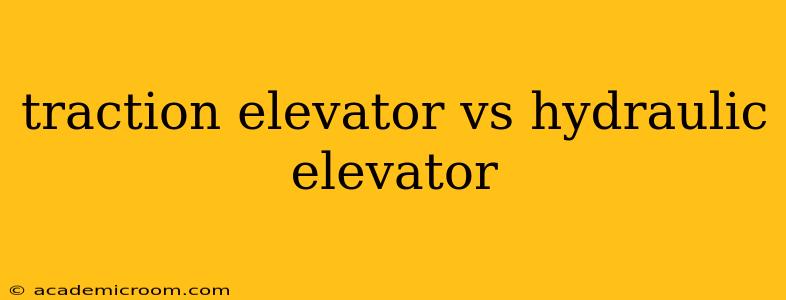Choosing the right elevator system for a building is a crucial decision, impacting efficiency, cost, and long-term maintenance. Two primary types dominate the market: traction elevators and hydraulic elevators. Understanding their differences is essential for informed decision-making. This comprehensive guide breaks down the key distinctions, helping you determine which system best suits your needs.
How Do Traction and Hydraulic Elevators Differ?
The fundamental difference lies in how they achieve vertical movement. Traction elevators use a counterweight system and steel cables to lift the elevator car. The motor drives a sheave (a grooved wheel) that moves the cables, raising or lowering the car. Hydraulic elevators, conversely, utilize a hydraulic piston and fluid pressure to lift the car. A pump pressurizes the hydraulic fluid, pushing the piston and the elevator car upwards.
What are the Advantages of Traction Elevators?
Traction elevators offer several key advantages:
- Higher Speeds and Taller Buildings: Traction elevators are far superior for high-rise buildings, capable of reaching much higher speeds and traveling greater distances than hydraulic elevators. This is because they aren't limited by the length of a hydraulic piston.
- Energy Efficiency (Generally): While initial energy consumption might be higher for some models, traction elevators generally exhibit better long-term energy efficiency, particularly in high-rise applications. Regenerative braking systems in modern traction elevators can even return energy to the building's power grid.
- Lower Maintenance Costs (Potentially): While initial installation might be more expensive, long-term maintenance costs can be lower compared to hydraulic elevators, particularly in high-rise buildings. Fewer moving parts in the system contribute to reduced maintenance requirements.
- Smoother Ride: Traction elevators often provide a smoother, more comfortable ride, particularly at higher speeds.
What are the Advantages of Hydraulic Elevators?
Hydraulic elevators also possess certain benefits:
- Lower Initial Cost: For low-rise buildings (typically up to five stories), the initial cost of installing a hydraulic elevator is usually lower than a traction elevator.
- Simpler Machine Room: Hydraulic elevators typically require a smaller and less complex machine room, saving space and potentially reducing construction costs.
- No Shaft Penetration Required: The absence of a hoistway in some hydraulic designs can streamline installation and reduce construction complexity, which is especially advantageous in renovations or buildings with limited space.
What are the Disadvantages of Traction Elevators?
While offering significant advantages, traction elevators also have some drawbacks:
- Higher Initial Cost: The initial investment for traction elevators, especially in higher-rise buildings, is considerably higher than for hydraulic systems.
- More Complex Installation: The installation of traction elevators is typically more complex and time-consuming, requiring specialized expertise and precise engineering.
- Higher Machine Room Requirements: Traction elevators demand larger machine rooms compared to hydraulic elevators.
What are the Disadvantages of Hydraulic Elevators?
Hydraulic elevators present some limitations:
- Limited Height and Speed: Hydraulic elevators are not suitable for tall buildings due to limitations in piston length and the slower speeds they can achieve.
- Environmental Concerns: Hydraulic systems typically use hydraulic fluid, which can pose environmental risks if not handled correctly. Modern systems are designed to minimize this, but it's still a consideration.
- Higher Energy Consumption (Generally): While there are exceptions, hydraulic elevators generally consume more energy compared to traction systems, especially for frequent use.
- Slower Speed: Hydraulic elevators are significantly slower than traction elevators.
What Type of Elevator is Best for My Building?
The ideal choice depends on several factors:
- Building Height: For buildings exceeding five stories, traction elevators are almost always the preferred choice. Hydraulic elevators are generally limited to low-rise applications.
- Budget: Initial cost considerations are significant. Hydraulic elevators might be more economical for low-rise buildings with limited budgets.
- Speed Requirements: If speed is a priority, traction elevators are necessary.
- Energy Efficiency Goals: Traction elevators, particularly with regenerative braking, offer better long-term energy efficiency.
- Maintenance Considerations: While hydraulic systems can have simpler components, the total maintenance cost over the lifespan of the elevator should be factored in.
Ultimately, consulting with an elevator professional is crucial to determine the best elevator type for your specific building requirements. They can assess your needs and recommend the most suitable and cost-effective solution.
